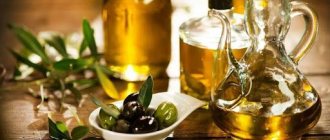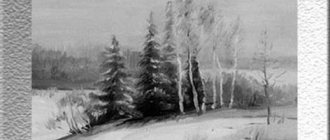Temples and monasteries carefully protect their shrines: the relics of holy people, icons that work miracles. Some icons, as well as the relics of Orthodox saints, exude myrrh. It is customary to carefully collect it and add it to Vaseline or vegetable oil. Also, drops of lamp oil from unquenchable lamps placed next to the relics and icons are added to the oil compositions.
The collected oil is poured into vessels that anyone can purchase and use for medicinal purposes. With the help of this consecrated oil, the physical condition of the believer improves, and mental anguish and anxiety calms down. The peculiarity of the action of consecrated oil is its rapid and quite powerful healing effect.
Anointing (Photo from pravoslavie.ru)
Oil of oil is a symbol of God's mercy
Olive oil with the addition of aromatic components, called oil, was consecrated through prayer and was actively used for healing since the first centuries of the development of Christianity.
Blessed oil has deep symbolism and is the embodiment of God's mercy, God's grace, and also correlates with the concepts of gracious joy and revival. The apostles used the oil to heal the sick and lepers. The rite of anointing with oil accompanied the process of giving a person a part of the Divine Spirit, which from the moment of sprinkling with oil remained in the soul of the believer unchanged.
The important sacrament of the Blessing of Anointing is also associated with the anointing of a Christian with consecrated oil in the name of God for the purpose of healing and accompanying him in earthly life in a state of being filled with the Holy Spirit. The Blessing of Oil not only healed ailments, but also absolved sins, that is, it brought the Christian into a pure state of grateful service to God. The power of the Blessing of Anointing lay mainly in the accompanying presbyteral prayer.
Regular anointing with consecrated oil outside the scope of the sacrament also heals the body and heals the soul, but does not have a power comparable to the effect of the Blessing of Anointing. Healing with consecrated oil involves the healing effect of the oil itself and its beneficial effects, although the power of the sick person’s prayer and the steadfastness of his faith also play a large role in recovery.
Oil is a symbol of eternal bliss and, together with wine and wheat, is the food given to people by God for life. The abundance of these three products is a sign of God's mercy and granted salvation. And the growing olive tree itself acts as a symbol of God’s righteous man, preparing himself for eternal life and steadily following the covenants.
How to use blessed oil?
The benefit from the use of consecrated oil will be, first of all, for every true believer Christian. The Apostle Paul truly stated that everything goes well for the believer. It is no coincidence that consecrated oil is credited with miraculous powers, but, of course, it is not so much the oil itself that heals, but prayers and the power of faith.
Blessed oil will especially quickly help those who live the life of the Church and do not miss Communion and Confession. After the service, when reading the house of prayer before going to bed, it is advised to anoint yourself with the consecrated oil.
The oil should be applied crosswise from the right side to the left, directly crossing the sore spot. After application, the oil can be rubbed for better absorption. The oil is applied either using a small brush specially purchased for this purpose, or with a candle wick.
The meaning of Holy Chrism for the church
Holy Myrrh is a special composition and a special recipe.
This oil is used at the most significant moment in the life of a new Christian. Immediately after a person is baptized, anointing with Myrrh is performed - once and for the rest of his life. This symbolizes his acceptance of the Holy Spirit.
Upon completion of the construction of a new church, the first thing to do is consecrate it with holy oil. The Myrrh is also anointed with a necessary attribute of any liturgy - the cloth covering the altar, or the antimins.
It is also known that anointing was performed on kings who ascended the throne. Therefore, they were also called God's anointed. This ritual was common in Byzantium and Rus'.
The symbolic significance of the World for the church is that it represents the gifts of the Holy Spirit. The numerous aromatic substances included in its composition personify many virtues of a true, sincerely believing Christian.
What types of blessed oil are there?
Blessed oil can be lamp oil, Vaseline oil, or vegetable oil. The latter is edible. It can be dripped in a small volume onto prosphora, artos, antidor or any food from the table, and then eat the food. When eating consecrated oil, be sure to read the appropriate prayer.
Non-edible consecrated oil is suitable for anointing. Church shops offer both oils consecrated on relics and simply oil compositions for lamps, which are also consecrated. There are strict rules regarding the use of oils in the Church.
So, for example, the oil that was used at the Blessing of Anointing cannot be placed in lamps or mixed with other substances, or poured out. Blessed oil is similar in power to holy water, but it is not suitable for sprinkling houses. This oil heals illnesses when applied to the body, and also invigorates the healthy spirit when anointing the heart and forehead area with a cross every morning.
Oil consecrated on the relics of saints is closely associated with the shrine to which it belongs. Accordingly, the Saint will help in illness, and prayers should be addressed to him. Also suitable for anointing is the prayer “Our Father...” or a prayer appeal to the Mother of God. If you do not know prayers, it is not forbidden to ask for healing in your own words: with due diligence and sincerity, the disease will go away under the influence of the consecrated oil.
Blessing of the oil (Photo from pravmir.ru)
Nicholas the Wonderworker
This saint is called so because prayers sent to him never go unheeded. In addition, he is an intercessor before the Lord for us. In addition, he is capable of performing miracles. This saint is considered the patron saint of sailors, travelers, orphans and prisoners. There are three days of veneration a year: December 19, May 22 and August 11.
The best article for you, go to: Prayer to St. Nicholas the Wonderworker for the sale of an apartment, house, car
He was called a miracle worker because of the miracles that he performed during his worldly life. Also, all children know about St. Nicholas, since every winter they expect gifts from him. Many believe that he is the prototype of Santa Claus.
Many pilgrims try to visit the places where his remains are kept, and since the relics were eventually transferred to Italy, those who travel to this country bring myrrh from St. Nicholas from Bari.
How to share blessed oil?
The result of a trip to distant Holy places is often the acquisition of numerous rare and especially healing consecrated oils from the relics. Such unique oils cure illnesses surprisingly quickly, but their volume is not so large that you can distribute the oil to everyone you know and those who are sick.
Diveyevo traditions allow in such cases to prepare a clean bottle, fill it with simple vegetable oil and, through accompanying prayers, consecrate it for donation. Prayers over the prepared composition must certainly include an appeal to the Mother of God, the prayer “Our Father...” and a prayer word to the saint from whose relics your oil is consecrated.
How to use myrrh from the relics of St. Nicholas the Wonderworker
There are no strict rules about how to use it. Some use it instead of drops or infusions, while others simply add it to the main therapy in the treatment of serious illnesses. In addition, it is not for nothing that St. Nicholas of Myra is called the Wonderworker, since even surgical intervention can prevent the ointment from his remains. Helps the world to get rid of temptations and bad thoughts. In difficult moments, when failures overtake you, you can draw a cross on your forehead with a cotton swab dipped in holy myrrh, and ask the miracle worker of Myra for help and intercession.
The best article for you, go to: The relics of St. Nicholas the Wonderworker: where they are, how to venerate
Which blessed oil has the greatest healing power?
Oil can be blessed for various reasons, but the most powerful is the blessed oil obtained after the Blessing of Anointing. This composition will become the most effective healing agent for the patient.
Oil consecrated at the lamps of places of great holy power, as well as brought from places with the relics of great elders and miraculous icons, is also considered the most potent. This oil should be smeared on painful areas of the body as often and intensely as the pain is severe. You can apply the oil directly, or use a cotton swab soaked in the composition, or a piece of fabric. These materials should subsequently be strictly burned, but not thrown away.
Blessed oil is suitable for the treatment of various diseases, and depending on the nature of the disease, oils are not divided. For migraines, the oil is applied to the temples, for infertility - to the lower abdomen, for allergies - to the most often damaged areas.
Interesting Facts
Photo: Elohov.ru
But today I would like to tell you about several interesting facts from the life of St. Nicholas the Wonderworker, which will help to more fully recognize this beloved saint of the Russian Orthodox Church.
Nicholas's homeland and the Russian coat of arms - how they are connected
Nikolai Ugodnik was born in 270 near the town of Lycia, which was located on the territory of modern Turkey, where the city of Gelemish is now located. Lycia was a village in the province of Patara, a Greek colony. Since Greece was at that time part of Byzantium, the inhabitants were also Orthodox and Nicholas is also an Orthodox saint. The Lycians differed only in origin - they descended from the ancient people of the Hittites, who had a double-headed eagle as their symbol. It was later used by Byzantium, and from there by Russia, as its coat of arms.
A slap in the face to the bishop – did it happen or didn’t it happen?
They say that Nicholas, who was at that time the Bishop of Myra, was present at the 1st Ecumenical Council. And there, during his speech, Bishop Arius began to speak heretical speeches and deny the Divine nature of Christ. Then Nicholas of Myra stood up, and in the presence of Emperor Constantine and 318 bishops, gave Arius a slap in the face, thereby interrupting his heretical delirium. This fact is sometimes confirmed by historians, sometimes refuted, but it has reached our times through millennia.
Where is the tomb of St. Nicholas the Wonderworker?
Photo: Flickr.com
Initially, the relics of the Saint were in Lycia. In 792, the Turks wanted to steal them, but they made a mistake and opened the wrong tomb. After they were expelled, a terrible storm arose at sea and the kidnappers died.
After this, more than 300 years passed and now, Italian Catholics wanted to transport the relics to the city of Bari in Italy. They succeeded, and the relics were placed in the Church of St. Stephen. Moreover, Nikolai Ugodnik did not object to such a move, because the discovery of the relics was accompanied in Italy by many miracles and healings of the sick.
Healing myrrh - a miracle inexplicable by science
The relics of St. Nicholas exude myrrh, which is a crystal-clear liquid with a pleasant sweetish aroma. Miro does not freeze even at very low temperatures. The relics began to emit liquid even before they were discovered in the city of Miro, where they were hidden under several layers of flooring in the temple, but, nevertheless, they emitted a fragrance, which is why they were discovered.
Miro has an undoubted healing effect, but no one can explain its nature. And the very fact of its appearance from particles of the saint’s body in such quantities is also completely inexplicable by materialistic laws.
Wonderful instructive stories in modern times
In 1955, in the city of Samara, in the USSR, an incredible event occurred - the girl Zoya Karnaukhova, who was with her friends at a party dedicated to the New Year, was left without a partner during the dance. Then she grabbed the icon of St. Nicholas the Wonderworker standing on the iconostasis and began to dance with it. But she immediately froze in place, like a stone. Her heart continued to beat, but she did not react to anything and it was impossible to move her. So she stood for 128 days, until Easter. On Easter, an old man unknown to anyone came into the house and asked her: “Are you tired of standing?” It was most likely the offended Saint Nicholas himself. Then Zoya was able to move and leave the place, but three days later she died.










